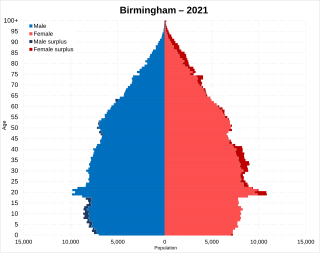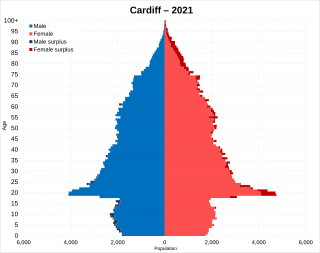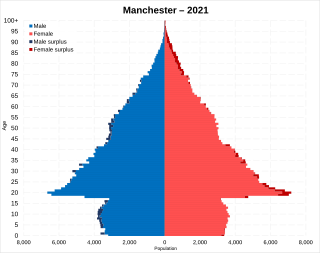| Part of a series on |
| Sikhism |
|---|
 |
The arrival of Sikhism in Wales is relatively recent. As of the 2021 United Kingdom census there were 4,048 Sikhs in the country representing 0.1% of the population. [1] [2]
| Part of a series on |
| Sikhism |
|---|
 |
The arrival of Sikhism in Wales is relatively recent. As of the 2021 United Kingdom census there were 4,048 Sikhs in the country representing 0.1% of the population. [1] [2]
| Year | Pop. | ±% |
|---|---|---|
| 2001 | 2,015 | — |
| 2011 | 2,962 | +47.0% |
| 2021 | 4,048 | +36.7% |
| Source: Office for National Statistics [3] [4] | ||
Sikhs have faced some difficulties in Wales: in 2000, a popular Sikh was murdered in a racially motivated attack in Port Talbot. [5] The issue of Sikhism in Wales again came to wider attention in 2008 when the only Sikh pupil at Aberdare Girls' School was banned from school for refusing to remove her kara [6] though the High Court eventually ruled that the school had been wrong to exclude her. [7]
The first purpose-built Sikh gurdwara was opened in Cardiff in 1989. [8]

The population of the United Kingdom was estimated at 67,596,281 in 2022. It is the 21st most populated country in the world and has a population density of 279 people per square kilometre, with England having significantly greater density than Wales, Scotland, and Northern Ireland. Almost a third of the population lives in south east England, which is predominantly urban and suburban, with 8,866,180 people in the capital city, London, whose population density was 5,640 inhabitants per square kilometre (14,600/sq mi) in 2022.

The demography of England has since 1801 been measured by the decennial national census, and is marked by centuries of population growth and urbanization. Due to the lack of authoritative contemporary sources, estimates of the population of England for dates prior to the first census in 1801 vary considerably. The population of England at the 2021 census was about 56,489,800.

The Metropolitan Borough of Rotherham is a metropolitan borough of South Yorkshire, England. It is named after its main settlement of Rotherham. The wider borough spans a larger area and covers the outlying towns of Maltby, Swinton, Wath-upon-Dearne, Dinnington. As well as the villages of Rawmarsh and Laughton. A large valley spans the entire borough and is referred to as the "Rother Valley".

Hinduism is the third-largest religious group in the United Kingdom, after Christianity and Islam; the religion is followed by over one million people representing around 1.6% of the total population. According to the 2021 United Kingdom census Hindus are primarily concentrated in England, particularly in Greater London and the South East, with just under 50,000 Hindus residing in the three other nations of the United Kingdom. Hindus have had a presence in the United Kingdom since the early 19th century, as at the time India was part of the British Empire. Many Indians in the British Indian Army settled in the United Kingdom of Great Britain and Northern Ireland.

The demography of London is analysed by the Office for National Statistics and data is produced for each of the Greater London wards, the City of London and the 32 London boroughs, the Inner London and Outer London statistical sub-regions, each of the Parliamentary constituencies in London, and for all of Greater London as a whole. Additionally, data is produced for the Greater London Urban Area. Statistical information is produced about the size and geographical breakdown of the population, the number of people entering and leaving country and the number of people in each demographic subgroup. The total population of London as of 2021 is 8,799,800.

Islam is a minority faith in Wales followed by 2.2 % of its population with about 64,000 adherents recorded as per 2021 Census up from about 46,000 adherents in the 2011 Census. The earliest recorded connections between Wales and the Muslim world dates back to the early 12th Century. There has been a Somali and Yemeni Islamic community in Cardiff since the mid-19th century, founded by seafarers to Cardiff Docks. The first purpose-built mosque was erected in Cardiff in 1947.

British Sikhs number over 535,000 people and account for 0.8% of the British population as of 2021, forming the United Kingdom's fourth-largest religious group. According to the 2021 United Kingdom census, British Sikhs numbered 535,517, with 520,092 in England, 10,988 in Scotland, 4,048 in Wales, and 389 in Northern Ireland. The largest Sikh populations in the United Kingdom are in the West Midlands and Greater London.

Religion in Wales has become increasingly diverse over the years. Christianity was the religion of virtually all of the Welsh population until the late 20th century, but it rapidly declined throughout the early 21st century. Today, a plurality (46.5%) of people in Wales follow no religion at all.

The demography of Birmingham, England, is analysed by the Office for National Statistics and data produced for each of the wards that make up the city, and the overall city itself, which is the largest city proper in England as well as the core of the third most populous urban area, the West Midlands conurbation.

Buddhism in the United Kingdom is the fifth-largest religious group in the United Kingdom. The 2021 United Kingdom census recorded just under 290,000 Buddhists, or about 0.4% of the total population, with the largest number of Buddhists residing in Greater London and South East England. According to a Buddhist organisation, the growth of Buddhism in the United Kingdom is mainly a result of conversions.

English Sikhs number over 520,000 people and account for 0.9% of England's population in 2021, forming the country's fourth-largest religious group. In 2006 there were 352 gurdwaras in England. The largest Sikh populations in the U.K. are in the West Midlands and Greater London.
Buddhism in England has growing support. 238,626 people in England declared themselves to be Buddhist at the 2011 Census and 34% of them lived in London.

Hinduism is a minority religion in Wales constituting 0.4% of its population. Under half of Welsh Hindus settled there in the second half of the 20th century.
Buddhism in Wales is followed by 0.3% of the Welsh population, according to the 2021 Census. Buddhism has a relatively short history, having only really established a presence in the country in the 20th Century. 10,075 people in Wales declared themselves Buddhist in the 2021 Census, representing a number of Buddhist traditions.

This article presents the historical demographics of Cardiff, capital city of Wales in the United Kingdom.
Irreligion in the United Kingdom is more prevalent than in some parts of Europe, with about 8% indicating they were atheistic in 2018, and 52% listing their religion as "none". A third of Anglicans polled in a 2013 survey doubted the existence of God, while 15% of those with no religion believed in some higher power, and deemed themselves "spiritual" or even "religious".

Bradford, England is an ethnically and culturally diverse city. The City of Bradford metropolitan borough is the sixth most populous local authority district in the United Kingdom, and includes not only Bradford but also the towns and villages of Keighley, Shipley, Bingley, Ilkley, Haworth, Silsden, Queensbury, Thornton and Denholme.

Bristol, England is the tenth most populous city in the United Kingdom.

Coventry, England is an ethnically and culturally diverse city. It is the fifteenth most populous city in the United Kingdom.

Manchester is a populous city in the North West of England. Its total population as of 2021 is 551,938.